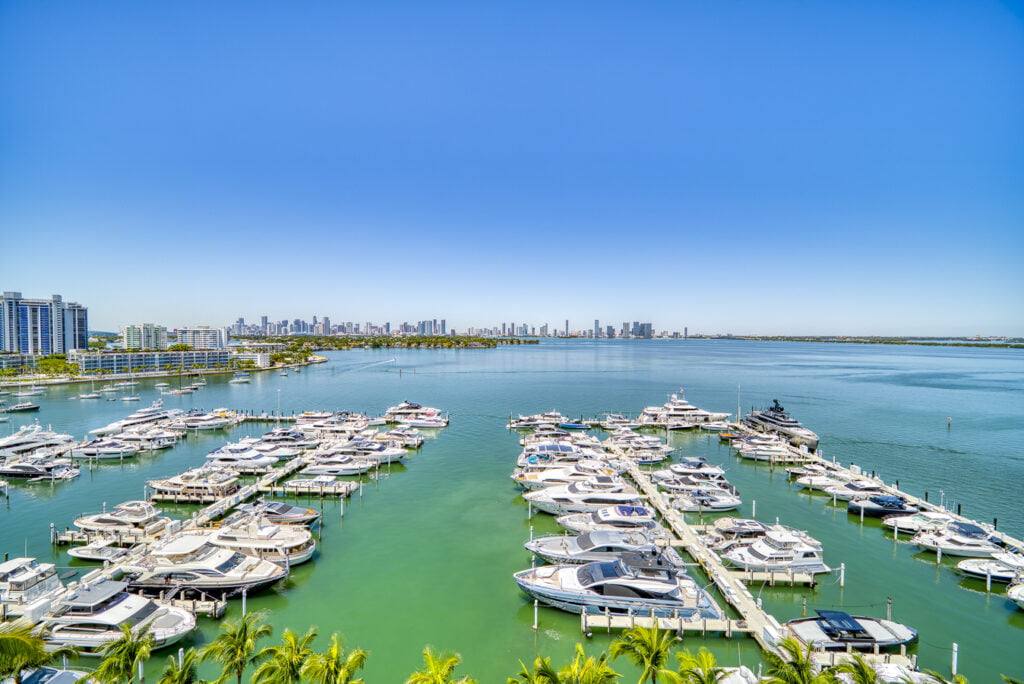
The Importance of High-Quality Real Estate Photography in Miami
In the competitive Miami real estate market, high-quality photography is not just an added benefit; it is a critical necessity. Properties listed with professional real estate photography receive significantly more attention compared to those with amateur photos. This is particularly important in Miami, where the market is saturated with luxury homes, beachfront properties, and high-rise condos, each vying for the attention of discerning buyers.
Professional real estate photography enhances the appeal of listings by capturing properties in their best light, literally and figuratively. High-quality visuals can highlight unique architectural features, expansive ocean views, and meticulously landscaped gardens, making the property more attractive to potential buyers. According to a study conducted by the National Association of Realtors, homes with professional photos can sell up to 32% faster than those without. In Miami-Dade County, this statistic holds even more weight given the competitive nature of the market.
Miami’s unique market dynamics mean that buyers often come from various parts of the world, relying heavily on online listings to make purchasing decisions. Professional photography can create a compelling first impression, significantly increasing the likelihood of attracting serious inquiries. High-definition images, coupled with advanced techniques like High Dynamic Range (HDR) photography, can showcase properties in vivid detail, enhancing their visual appeal and capturing the essence of the Miami lifestyle.
Case studies from Miami-Dade County illustrate the transformative impact of high-quality real estate photography. For instance, a luxury condo in Brickell saw a 50% increase in showings after investing in professional photography, leading to a sale within weeks. Similarly, a beachfront property in Key Biscayne, initially on the market for months, sold within days after updating its listing with professionally taken photos.
In summary, the significance of professional real estate photography in Miami cannot be overstated. High-quality visuals not only make properties stand out in a crowded market but also expedite the selling process, ultimately benefiting both sellers and buyers in the vibrant Miami real estate landscape.
Why Use HDR Photography for Real Estate Listings?
HDR (High Dynamic Range) photography has become a cornerstone in real estate marketing due to its ability to produce images with a greater range of light and detail. This advanced photographic technique merges multiple exposures to create a single image that captures the full spectrum of light, from the darkest shadows to the brightest highlights. For real estate listings, the benefits of HDR photography are manifold, significantly improving the visual appeal and accuracy of property images.
One of the primary advantages of HDR photography is its enhanced image quality. By combining different exposures, HDR images offer a more realistic and vibrant portrayal of a property. This is particularly beneficial for Miami real estate, where homes often feature bright and inviting outdoor spaces, as well as luxurious interiors. The accurate depiction of these elements can make a significant difference in attracting potential buyers.
Another key benefit is the better representation of property features. Traditional photography can struggle with high-contrast scenes, often resulting in overexposed or underexposed areas. HDR photography overcomes this limitation by balancing the light across the image, ensuring that every detail is visible. This is crucial for showcasing the unique architectural features and intricate design elements that many Miami homes boast.
Furthermore, HDR photography can improve the overall appeal of real estate listings. High-quality, detailed images are more likely to capture the interest of potential buyers, increasing engagement and the likelihood of viewings. In a competitive market like Miami, where first impressions are crucial, HDR photography can provide a significant edge.
From a technical standpoint, HDR photography involves taking multiple shots at different exposure levels and blending them together. This process requires specialized equipment and software, as well as expertise in post-processing to achieve the desired results. However, the investment in HDR photography is well worth it, given the substantial benefits it offers in terms of image quality and property representation.
In summary, HDR photography is particularly advantageous for Miami real estate listings. Its ability to capture the full range of light and detail results in stunning, realistic images that better showcase property features and enhance overall appeal. As such, HDR photography should be a key component of any real estate marketing strategy in Miami.
Preparing Your Home for a Real Estate Photo Shoot
Proper preparation is essential to ensure that your home looks its best in real estate photographs. This process involves several critical steps, including decluttering, staging, optimizing lighting, and performing minor repairs. Each of these elements plays a pivotal role in enhancing the visual appeal of your property, thereby attracting more potential buyers.
Decluttering
Decluttering is the first and perhaps most crucial step in preparing your home for a photo shoot. A clutter-free space appears larger, cleaner, and more inviting. Remove personal items such as family photos, knick-knacks, and excess furniture. This helps potential buyers envision themselves in the space without distractions. Additionally, ensure countertops, shelves, and other surfaces are clear of unnecessary objects.
Staging
Staging involves arranging furniture and décor to highlight the home’s best features. Opt for a neutral color palette and minimalistic décor to appeal to a broader audience. Arrange furniture in a way that maximizes space and creates a natural flow from room to room. Thoughtful staging can transform a mundane space into an attractive, welcoming environment that resonates with buyers.
Lighting
Lighting is another critical factor in real estate photography. Natural light is your best friend; open curtains and blinds to allow as much sunlight as possible to flood the rooms. For areas with limited natural light, consider using artificial lighting to brighten the space. Soft, even lighting can eliminate shadows and highlight the home’s architectural details, making the property appear more inviting and vibrant in photos.
Minor Repairs
Before the photo shoot, take the time to address any minor repairs that could detract from the home’s appearance. This includes fixing leaky faucets, patching up holes or cracks in the walls, and ensuring all light fixtures are functional. These small fixes can make a significant difference in the overall presentation of the home, making it look well-maintained and move-in ready.
By focusing on these key areas—decluttering, staging, lighting, and minor repairs—you can ensure that your home is captured in the best possible light. High-quality real estate photographs are instrumental in creating a strong first impression, ultimately drawing more interest from potential buyers and increasing the likelihood of a successful sale.
10 Essential Steps to Take Before Your Real Estate Photographer Arrives
Preparing your home for a real estate photography session is crucial in presenting it in the best possible light. Adhering to these 10 essential steps will ensure your home is camera-ready, enhancing its appeal to potential buyers.
1. Declutter all rooms: Removing excess items from each room can make spaces appear larger and more inviting. Focus on clearing surfaces, organizing shelves, and storing away unnecessary items.
2. Remove personal items: Depersonalizing your home by removing family photos, personal memorabilia, and other personal items helps potential buyers visualize themselves living in the space.
3. Clean windows and mirrors: Sparkling clean windows and mirrors maximize natural light and reflectivity, adding to the overall brightness and appeal of each room. Use streak-free cleaning solutions for the best results.
4. Ensure all lights are working: Replace any burnt-out bulbs and ensure that all lighting fixtures are functional. Consistent lighting throughout the home contributes to a cohesive and welcoming atmosphere.
5. Stage furniture appropriately: Arrange furniture to highlight the room’s best features and create a natural flow. Avoid overcrowding spaces and consider removing any pieces that disrupt the visual harmony.
6. Add decorative touches: Small decorative elements such as fresh flowers, throw pillows, and tasteful artwork can enhance the aesthetic appeal of your home without overwhelming the space.
7. Clean and organize outdoor spaces: A well-maintained exterior is just as important as the interior. Mow the lawn, trim bushes, and remove any debris. Arrange patio furniture neatly and consider adding potted plants for a touch of greenery.
8. Make minor repairs: Address any small repairs such as fixing leaky faucets, patching up holes in walls, and tightening loose doorknobs. These minor fixes can prevent potential distractions during the photography session.
9. Adjust blinds and curtains: Ensure all blinds and curtains are open to maximize natural light. Properly adjusted window treatments can also frame views and contribute to the overall ambiance.
10. Create a welcoming ambiance: Pay attention to details such as setting the thermostat to a comfortable temperature, playing soft background music, and adding pleasant scents. These subtle touches can make your home feel more inviting.
By following these steps, homeowners can significantly enhance the visual appeal of their property, ensuring that the real estate photography session captures its full potential. Implementing these preparations will contribute to more compelling images that can attract prospective buyers and ultimately lead to a successful sale.
